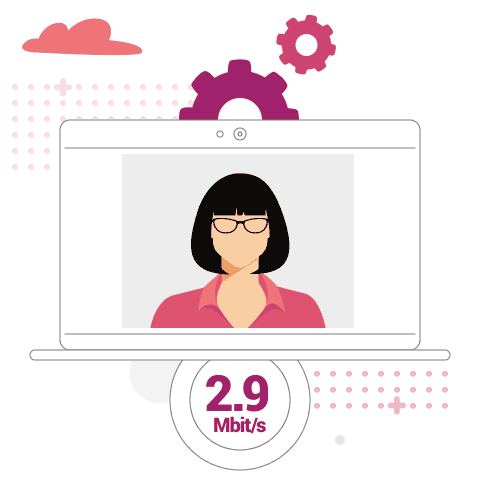
COVID-19 and the increased bandwidth usage problem
COVID-19 and the need for low bandwidth meetings
This surge in remote work raises the question of whether video conferencing and other collaboration tools can scale to handle coronavirus-related traffic without disrupting the internet infrastructure. People who work from home are trying to have important meetings but worry about the diminishing quality. During large group video meetings, especially where each additional user increases the bandwidth, users often get kicked out. Unlike other video meeting solutions, eyeson relies on a unique patented core technology called Single Stream Technology (SST). Due to this technology, users can hold large meetings through video conferencing and stable bandwidth at approximately 2 Mbits. Regardless of how many participants take part in the group video call, bandwidth stays low. A central entity collects all the video streams, merges it into one single stream, and then sends out one single stream to all participants. The bandwidth stays low, even with up to 100 participants in a call.Video meetings are helping businesses stay alive
The world is going through fundamental changes , and the economy needs to be kept alive. Video meetings have never been more critical in helping businesses thrive. Now, more than ever, do we rely on tools that keep our teams connected and our cooperation going strong. Scalability matters because even when this crisis will be over, people won't go back to their old ways. They will undoubtedly question unnecessary business trips and opt for video meetings more often. The benefits of video meetings are endless, and sometimes people need a good reason to get started. We've always hoped that digital tools would end up creating connections, not conflict. Now we have a chance to make it happen. This crisis causes business to reconsider their old ways.Social distancing does not feel all that lonely
Many people expected the first weeks of social distancing to feel very lonely and isolated. However, some have claimed to feel more connected than ever. People use video meetings to have social gatherings and are seeing the benefits of meeting online. Stand-up meetings have quickly manifested themselves into working people's lives. Strangers and experts are sharing valuable information about the virus on social media and organizing ways to help struggling people and small businesses. This crisis is only keeping us distant from each other in person, not any less connected.
While there are some positive aspects, there is no doubt that there are devastating consequences for people all over the world. Unfortunately, they may get much worse in the months ahead. Many more lives will be lost, businesses closed, and communities are facing financial hardship. Nobody is arguing that what lies ahead be fun, easy, or anything close to normal for a long time.
The COVID-19 is forcing us to use the internet differently
But if there is a silver lining in this crisis, it is that the virus is forcing us to use the internet the way it was meant to be used — to stay connected, share information and resources, and come up with collective solutions to urgent problems. Not every business meeting needs to be in person . Many people are realizing that it is not always necessary to meet physically . Sometimes it makes more sense to meet virtually, no matter if it’s just a one-on-one client call or a conference including dozens of colleagues from different departments in different locations. Which is precisely why video meetings need to be scalable.
Only if we use this momentum and allow for businesses and everyone to continue "work as usual" will we be able to benefit from this crisis. Crisis times are often transformative and disruptive, and it is up to us what we make out of them.


